Fieldwork on the Islands of Oreor and Babeldaob, Republic of Belau (Palau), Micronesia, 1987
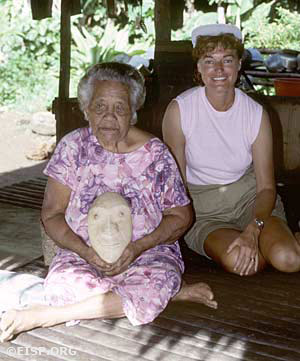
Jo Anne Van Tilburg and an elder of the Babelblai family of Ngiwal. ©1987 EISP/JVT/ Photo: D. C. Ochsner
In 1987 we were drawn to Belau by a statue described by archaeologist Douglas Osborne, who had worked there in the 1960s, as “strikingly like those of Easter Island.” Although he said it was “more conventionalized” and “less naturalistic” than Easter Island sculpture, the possibility that it resembled moai was intriguing, and we undertook eight weeks of intensive field survey work in the Republic of Belau (Palau). Our intent was to collect data on the formal and stylistic qualities of the statue Osborne had described, and then to record any others we might find. The aim was to gather enough data to constitute one component of a comparative study of Pacific monolithic stone sculpture.
Stone statues or monuments in Belau are one of ten elements that define Level 1, a “village settlement system” of a two level settlement system research model. Archaeologists conducting island-wide surveys have classified artifacts, areas, or features into three categories: discrete portable objects (potsherds, chipped and ground stone); discrete non-portable features (platforms, statues, uprights); and non-discrete, non-portable areas (terraces).

Monolith number 28 at Ngereklngong (total height 1.03 m) is an example of type variety A1 (called Chesuch or “owl”). Photo by David C. Ochsner, ©1987 Jo Anne Van Tilburg.
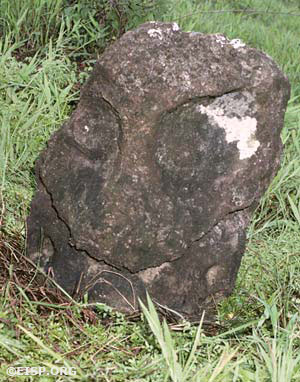
Monolith number 22 at Bairulchau (total height 1.74 m) is an example of variety A3 (“fanged mouth”). Photo by David C. Ochsner, ©1987 Jo Anne Van Tilburg.

Monolith number 01 (total height, 85.4 cm) at Ngerbodel is the only figure (type D) documented in Belau that unambiguously consists of head and torso carved out of one piece of stone. Photo by David C. Ochsner, ©1987 Jo Anne Van Tilburg.
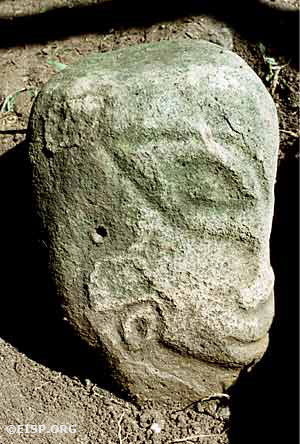
Monolith number 10 (total height 42.3 cm) was excavated on property belonging to the Omenckngkar family at Melekeok and is called by the name of a god, Mengachui. It is an example of figure type variety B5. Photo by David C. Ochsner, ©1987 Jo Anne Van Tilburg.
We located thirty-eight monoliths on the islands of Babledaob and Oreor (Koror), twenty-eight of which had human features. These were fully measured, mapped, photographed, drawn, and in some cases, cleared or partially excavated. After analysis of the features we were able to group them into four type categories. The resultant sculpture typology was then related to archaeological context, and some issues of function and meaning were clarified through ethnographic data, rock art analysis, and comparative study.
Rapa Nui people have traditionally referred to their statues as moai (the “living face” of their ancestors), and Belauans call their stone carvings klidm, or “face.” Both terms are generic classifications that conclude sculptures of varying types and sizes. When we finally located the statue Osborne believed resembled an Easter Island moai (project number 27), we discovered that it was only 63.5 m tall. Carved of andesite, it was broken, very worn and eroded. Called Iechadrachuolu (“Mr. Protection”), it was situated on exactly the same spot at Imeong where Osborne had first seen it. It was upright, facing west on the shoreline at the mouth of the Ngerdong River.
The figure had no facial features, but it was wearing a rounded “headdress” and had a pronounced, overhanging brow. It fit nicely with the style of another figure in the same area to which, as Osborne had originally stated, it was “obviously related.” The carving was not similar, in any real way, to Easter Island statues, and was well within the Belauan tradition. It and the other figures we recorded were all part of an integrated expression of local artistic concepts, and demonstrated formal and symbolic continuity as well as transformation over time.
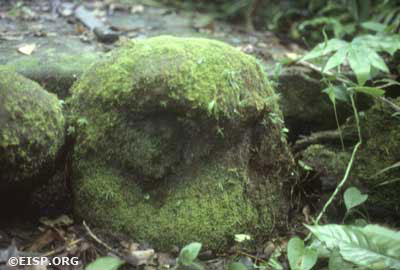
Monolith number 16 (total height 40 cm) at Ngkeklau is another example of type variety A1. It is broken, heavily covered with moss, and has been incorporated into the platform base of a stone structure. Photo by David C. Ochsner, ©1987 Jo Anne Van Tilburg.
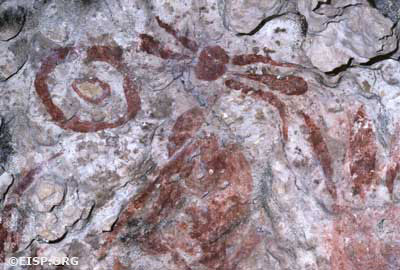
Site 4 on Oolong has intricate pictographs that relate to the designs painted on traditional village houses (bai).Photo by David C. Ochsner, ©1987 Jo Anne Van Tilburg.
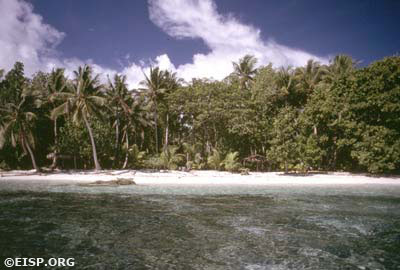
1987: “Englishmans Beach” at Oolong and many other places were explored for rock art. Photo by David C. Ochsner, ©1987 Jo Anne Van Tilburg.
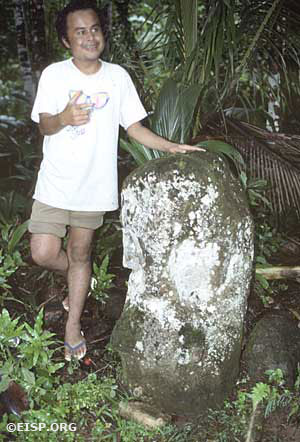
Kempis Mad of the Belau Museum with monolith number 08 (total height 1.46 m), another example of variety A1. Photo by David C. Ochsner, ©1987 Jo Anne Van Tilburg.
Want to know more?
Hijikata, H. 1956. “Report on Consecrated Stone Images and Other Stone Works in Palau, Micronesia.” Japanese Journal of Ethnology20(3,4):1-54. The English translation may be found in Stone Images of Palau. Guam: Micronesian Area Research Center Publication No. 3.
Osborne, D. 1966. The Archaeology of the Palau Islands: An Intensive Survey. Honolulu: Bernice P. Bishop Museum Bulletin 230.
Van Tilburg, Jo Anne 1991. “Anthropomorphic stone monoliths on the islands of Oreor and Babeldaob, Republic of Belau (Palau), Micronesia.” Honolulu: Bernice P. Bishop Museum Occasional Papers 31, pp. 3-62. [pdf, 41MB]
 English
English  Español
Español